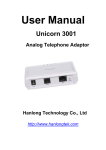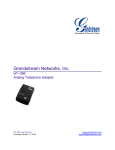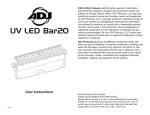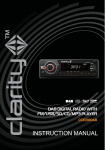Download User Manual
Transcript
User Manual
Unicorn 3101
Analog Telephone Adaptor
Hanlong Technology Co., Ltd
http://www.hanlongtek.com
Table of Content
1
2
3
WELCOME ................................................................................................................ 3
WHAT IS IN THE PACKAGE..................................................................................... 3
PRODUCT OVERVIEW ............................................................................................. 3
3.1
Key Features ............................................................................................... 3
3.2
Hardware specification ................................................................................ 4
4
INSTALLATIONS....................................................................................................... 5
4.1
Safety .......................................................................................................... 6
5
BASIC OPERATIONS ............................................................................................... 6
5.1
Get Familiar with Voice ................................................................................ 6
5.2
Make Phone call .......................................................................................... 8
5.2.1
Calling Phone or Extension Numbers................................................... 8
5.2.2
Call Hold ............................................................................................... 8
5.2.3
Call Waiting .......................................................................................... 8
5.2.4
3-way Conferencing.............................................................................. 8
Star Code Style 3-way Conference ..................................................................... 8
Bellcore Style 3-way Conference ........................................................................ 9
5.2.5
Direct IP-to-IP Calls .............................................................................. 9
5.2.6
Blind Transfer ..................................................................................... 10
5.2.7
Attended Transfer ............................................................................... 10
5.2.8
Make and Receive PSTN Calls ...........................................................11
5.3
Call Features ..............................................................................................11
5.3.1
Call Features Tables ............................................................................11
5.3.2
PSTN Pass Through........................................................................... 12
5.4
FAX............................................................................................................ 12
5.5
Status Light Indicator ................................................................................. 12
6
CONFIGURATION GUIDE....................................................................................... 13
6.1
Configuring Unicorn3101 using Web Browser ........................................... 13
6.1.1
Accessing the Web Configuration....................................................... 13
6.1.2
Programming Unicorn 3101 via the LAN Port..................................... 13
6.1.3
Programming Unicorn 3101 via the WAN Port ................................... 14
6.1.4
User Programming and Configuration ................................................ 14
6.1.5
Passwords .......................................................................................... 14
6.1.6
Configuration Options and Explanations ............................................ 15
6.1.6.1 Device Status .............................................................................. 15
6.1.6.2 Basic Options Settings ................................................................ 15
6.1.6.3 Super Options Setting ................................................................. 17
6.1.6.4 FXS Port ..................................................................................... 18
6.1.7
Saving the Configuration Changes ..................................................... 25
6.1.8
Rebooting the Unicorn 3101 ............................................................... 26
6.2
Configuring Unicorn 3101 via Voice Prompt .............................................. 26
6.2.1
DHCP Mode ....................................................................................... 26
Hanlong Technology Co., Ltd
1/19/2012
Unicorn 3101 User Manual
Firmware 1.0.0.46
Page 2 of 28
Last Updated
6.2.2
Static IP Mode .................................................................................... 26
6.3
Configuration through a Central Server ..................................................... 26
7
8
9
SOFTWARE UPGRADE.......................................................................................... 27
RESTORE FACTORY DEFAULT SETTINGS.......................................................... 27
TECHNICAL SUPPORT CONTACT........................................................................ 28
1
WELCOME
Unicorn 3101 is an all-in-one VoIP integrated access device that features superb audio
quality, rich functionalities, high level of integration, compactness and ultra-affordability.
The Unicorn 3101 is fully compatible with SIP industry standard and can interoperate with
many other SIP compliant devices and software on the market.
Special compatibility features include:
Nortel MCS
Standard SIP
Broadsoft
Howdy
2
WHAT IS IN THE PACKAGE
The Unicorn 3101 package contains:
One Unicorn 3101 VoIP adapter
One universal power supply
One Ethernet cable
One phone cable
3
PRODUCT OVERVIEW
3.1
Key Features
Supports SIP 2.0(RFC 3261), TCP/UDP/IP, RTP/RTCP, HTTP, ICMP,
DNS, DHCP (both client and server), NTP, PPPoE, STUN, TFTP, etc.
Built-in router, NAT, Gateway and DMZ port forwarding
Supports call origination and termination from/to the PSTN network
Powerful digital signal processing (DSP) to ensure superb audio quality;
advanced adaptive jitter control and packet loss concealment technology
Support various vocoders including G.711 (a-law
Hanlong Technology Co., Ltd
1/19/2012
Unicorn 3101 User Manual
Firmware 1.0.0.46
and
u-law),
ARP/RARP,
G.723.1
Page 3 of 28
Last Updated
(5.3K/6.3K,optional), G.726 (32K), as well as G.729A/B, and iLBC(Pending).
Support Caller ID/Name display or block, Hold, Call Waiting/Flash, Call Transfer, Call
Forward, in-band and out-of-band DTMF, Dial Plans, etc.
Support fax pass through and T.38.
Support Silence Suppression, VAD (Voice Activity Detection), CNG (Comfort Noise
Generation), Line Echo Cancellation (G.168), and AGC (Automatic Gain Control)
Support standard encryption and authentication (DIGEST using MD5 and MD5-sess)
Signaling and call encryption via TLS and SRTP, enabling enterprise-class security.
Support snmp v2
Support for Layer 2 (802.1Q VLAN, 802.1p) and Layer 3 QoS (ToS, DiffServ, MPLS)
Support automated NAT traversal without manual manipulation of firewall/NAT ,and
STUN, UPNP.
Support device configuration via built-in IVR, Web browser or central configuration file
through TFTP or HTTP
Support firmware upgrade via TFTP or HTTP with encrypted configuration files.
Support volume amplification
Support configurable Call Progress Tones
Ultra compact (wallet size) and lightweight design, great companion for travelers
Compact, lightweight Universal Power adapter.
3.2
Hardware specification
Model
Unicorn 3101
LAN interface
WAN interface
FXS telephone port
PSTN Pass Through
LED light
1 x RJ45 100MBase-T
1 x RJ45 100MBase-T
1 x FXS
1 x RJ11
Green and red color
Universal switching power supply
Dimension
Weight
Input: 100-240VAC 50-60 Hz
Output: +5VDC, 1200mA,
CE certification
70mm (W) ×130mm (D)×27mm (H)
0.30kg
Temperature
40 – 130 F
5 – 45 C
Humidity
10 - 90%
Hanlong Technology Co., Ltd
1/19/2012
Unicorn 3101 User Manual
Firmware 1.0.0.46
Page 4 of 28
Last Updated
4
INSTALLATIONS
The Unicorn 3101 is an all-in-one VoIP integrated device designed to be a total solution for
networks providing VoIP services. The Unicorn 3101 VoIP features are available when
you connect any regular analog telephone to it.
Unicorn 3101 has one FXS port (labeled “Phone”) and one PSTN pass through port
(labeled “Line”). After setting up the Unicorn 3101, you can make PSTN calls by pressing
*00. Without pressing *00, all your calls will be VoIP. You can also receive PSTN calls and
VoIP calls.
The following photo illustrates the Interconnection Diagram of the of a Unicorn 3101:
Following are the steps to install a Unicorn 3101:
Connect a standard touch-tone analog telephone to the “Phone” port.
Insert a standard RJ11 telephone cable (included with package) into the “Line” port
and connect the other end of the telephone cable to a wall jack.
Connect a PC to the LAN port of Unicorn 3101 (Ethernet cable is included with
package).
Insert another Ethernet cable into the WAN port of Unicorn 3101 and connect the
other end of the Ethernet cable to an uplink port (a router, switch, hub, modem, etc)
Hanlong Technology Co., Ltd
1/19/2012
Unicorn 3101 User Manual
Firmware 1.0.0.46
Page 5 of 28
Last Updated
Insert the powers supply (included
it to a power outlet.
4.1
with package) into the Unicorn 3101 and connect
Safety
The Unicorn 3101 is compliant with various safety standards including FCC/CE and CTick. Its power adaptor is compliant with UL standard. The Unicorn 3101 should only
operate with the universal power adaptor provided in the package.
Warning: Please do not use a different power adapter. Using other power
adapter may damage the Unicorn 3101 and will void the manufacturer
warranty!
Caution: Changes or modifications to this product not expressly approved by Hanlong
Technology, or operation of this product in any way other than as detailed by this User
Manual, could void your manufacturer warranty.
Information in this document is subject to change without notice. No part of this document
may be reproduced or transmitted in any form or by any means, electronic or mechanical,
for any purpose without the express written permission of Hanlong Technology.
5
BASIC OPERATIONS
5.1
Get Familiar with Voice
Unicorn 3101 has stored a voice prompt menu for quick access to settings and simple
configuration. You can enter this voice prompt menu one ways
Pick up the receiver (or press the Handsfree button) of the analog telephone and
press “***”
A voice will say, “Enter the new option.” At this point, you can select from the following
menu voice prompt options to begin using the Unicorn 3101:
Menu
Main
Menu
Voice Will Say the Following:
“Enter a Menu Option”
Enter “*” for the next menu option
Enter “#” to return to the main menu
Enter 01 – 07,12 - 17, 47, 86 or 99 Menu
option
01
“DHCP Mode”, “Static IP Mode”
Enter ‘9’ to toggle the selection
If user selects “Static IP Mode”, user need
configure all the IP address information
through menu 02 to 05.
If user selects “Dynamic IP Mode”, the
device will retrieve all IP address
information from DHCP server
Hanlong Technology Co., Ltd
1/19/2012
Unicorn 3101 User Manual
Firmware 1.0.0.46
Page 6 of 28
Last Updated
automatically when user reboots the
device.
02
“IP Address “ + IP address
The current WAN IP address is
announced Enter 12-digit new IP address
if in Static IP Mode.
03
“Subnet “ + IP address
Same as Menu option 02
04
“Gateway “ + IP address
Same as Menu option 02
05
“DNS Server “ + IP address
Same as Menu option 02
06
“MAC Address”
Announces the Mac address of the unit.
07
Preferred Vocoder
Enter “9” to go to the next selection in the
list:
PCM U
PCM A
G-726
G-723
G-729
12
WAN Port Web Access
Enter “9” to toggle between enable and
disable
13
Firmware Server IP
Announces current Firmware Server IP
address. Enter 12 digit new IP address.
Address
14
Configuration Server IP
Address
15
Upgrade Protocol
Announces current Config Server Path IP
address. Enter 12 digit new IP address.
Upgrade protocol for firmware and
configuration update.
Enter “9” to toggle between TFTP and
HTTP
16
Firmware Version
Firmware version information.
17
Firmware Upgrade
Firmware upgrade mode. Enter “9” to
rotate among the following three options:
1.
always check
2.
check when pre/suffix changes
3.
never upgrade
47
“Direct IP Calling”
Enter the target IP address to make a
direct IP call, after dial tone. (See “Make
a Direct IP Call”.)
99
“RESET”
Enter “9” to reboot the device; or
Enter MAC address to restore factory
default setting (See Restore Factory
Default Setting section)
“Invalid Entry”
Automatically returns to Main Menu
Other Menu Prompt Features:
Just like pressing “***” on the analog telephone, you will hear “Direct IP Calling”,
Hanlong Technology Co., Ltd
1/19/2012
Unicorn 3101 User Manual
Firmware 1.0.0.46
Page 7 of 28
Last Updated
which is just like selecting option 47 from the table above.
“*” shifts down to the next menu option
“#” returns to the main menu
“9” functions as the ENTER key in many cases to confirm an option
All entered digit sequences have known lengths - 2 digits for menu option and 12
digits for IP address. Once all of the digits are collected, the input will be processed.
Incorrect keyed entry cannot be deleted or undone. The Unicorn 3101 will prompt you
to start over by telling you that you made an error.
5.2
Make Phone call
5.2.1
Calling Phone or Extension Numbers
Dial the number directly and wait for 4 seconds (Default is 4 seconds. To change the
default, change the settings via the web configuration page under “No Key Entry
Timeout”). Or
Dial the number directly, and press # (assuming that “Use # as Dial Key” is set to
“YES” during web configuration of your Unicorn 3101).
Other functions available during the call are call-waiting/flash, call-transfer, and callforward. Your SIP gatekeeper/proxy server needs to support these features in order for
them to work.
5.2.2
Call Hold
While in conversation, pressing the “FLASH” button on the attached phone will put the
remote end on hold. Pressing the “FLASH” button again will release the previously Hold
party and the bi-directional media will resume.
5.2.3
Call Waiting
If call waiting feature is enabled, while the user is in a conversation, he will hear a special
stutter tone if there is another incoming call. User can press the flash button to put the
current call party on hold and switch to the other call. Pressing flash button toggles
between two active calls.
5.2.4
3-way Conferencing
Unicorn3101 supports 3-way conference in two styles: star code style or Bellcore style.
Star Code Style 3-way Conference
Assuming that call party A and B are in conversation. A wants to bring C in a conference:
Hanlong Technology Co., Ltd
1/19/2012
Unicorn 3101 User Manual
Firmware 1.0.0.46
Page 8 of 28
Last Updated
1. A presses FLASH (on the analog phone, or Hook Flash for old model phones) to get a
dial tone.
2. A dials *23 then C’s number then # (or wait for 4 seconds).
3. If C answers the call, then A press “flash” to bring B, C in the conference.
4. If C does not answer the call, A can press “flash” back to talk to B.
Bellcore Style 3-way Conference
Bellcore style 3-way conference is also supported. To do this, user needs to enable “Use
Bell-style 3-way Conference” in FXS web configuration.
Assuming that call party A and B are in conversation. A wants to bring C in a conference:
1. A presses FLASH (on the analog phone, or Hook Flash for old model phones) to get a
dial tone.
2. A dials C’s number then # (or wait for 4 seconds).
3. If C answers the call, then A press “flash” to bring B, C in the conference.
4. If C does not answer the call, A can press “flash” back to talk to B.
5.2.5
Direct IP-to-IP Calls
Direct IP calling allows two parties, that is, a FXS Port with an analog phone and another
VoIP Device, to talk to each other in an ad hoc fashion without a SIP proxy.
Elements necessary to completing a Direct IP Call:
1. Both Unicorn3101 and other VoIP Device, have public IP addresses, or
2. Both Unicorn3101 and other VoIP Device are on the same LAN using private IP
addresses, or
3. Both Unicorn3101 and other VoIP Device can be connected through a router using
public or private IP addresses (with necessary port forwarding or DMZ).
Unicorn3101 supports two ways to make Direct IP Calling:
Using IVR
1. Pick up the analog phone then access the voice menu prompt by dial “***”
2. Dial “47” to access the direct IP call menu
3. Enter the IP address using format ex. 192*168*0*160 after the dial tone.
Using Star Code
1. Pick up the analog phone then dial “*47”
2. Enter the target IP address using same format as above.
Note: NO dial tone will be played between step 1 and 2.
Destination ports can be specified by using “*” (encoding for “:”) followed by the port
number.
Examples:
a) If the target IP address is 192.168.0.160, the dialing convention is
*47 or Voice Prompt with option 47, then 192*168*0*160.
followed by pressing the “#” key if it is configured as a send key or wait 4 seconds. In this
case,the default destination port 5060 is used if no port is specified.
Hanlong Technology Co., Ltd
1/19/2012
Unicorn 3101 User Manual
Firmware 1.0.0.46
Page 9 of 28
Last Updated
b) If the target IP address/port is 192.168.1.20:5062, then the dialing convention would be:
*47 or Voice Prompt with option 47, then 192*168*0*160*5062 followed by pressing the
“#” key, if it is configured as a send key or wait for 4 seconds.
NOTE: When completing direct IP call, the “Use Random Port” should set to “NO”.
5.2.6
Blind Transfer
Assuming that call party A and party B are talking to each other on the phone. Party A
wants to transfer party B to party C:
Party A presses FLASH (on the analog phone, or Hook Flash for old model phones)
to get a dial tone.
Then party A dials *87 then dials party C’s number, and then # (or wait for 4 seconds)
Party A can hangs up the phone.
Note: Call features have to be activated during web configuration by selecting YES to
“Enable Call Features”. These features need to be supported by your
SIP gatekeeper/proxy server in order to work.
Party A can hold on to the phone and wait for one of the three following events:
1.
A quick confirmation tone (temporarily using the call waiting indication tone) followed
by a dial tone.This indicates the transfer is successful (transferee has received a 200
OK signal from transfer target). At this point, party A can either hang up or make
another call.
2.
A quick busy tone followed by a restored call (on supported SIP
gatekeeper platforms only).
This means the transferee has received a 4xx
response signal for the INVITE and will try to recover the call. The busy tone is just to
indicate to the transferor that the transfer has failed.
3.
Busy tone keeps playing. This means the Unicorn 3101 has failed to receive the
second NOTIFY signal from the transferee and decided to time out.
Note: this does not indicate the transfer has been successful, nor does it indicate the
transfer has failed. When transferee uses a device that does not support the second
NOTIFY signal, this will be the case. In poor or unstable network scenarios, this could also
happen, although the transfer may have been completed successfully.
5.2.7
Attended Transfer
Assuming that call party A and party B are in conversation. Party A wants to Attend
Transfer party B to party C:
Party A presses FLASH (on the analog phone, or Hook Flash for old model phones)
to get a dial tone.
Party A then dials party C’s number then # (or wait for 4 seconds).
Hanlong Technology Co., Ltd
1/19/2012
Unicorn 3101 User Manual
Firmware 1.0.0.46
Party A and party
Page 10 of 28
Last Updated
C now are in conversation.
Party A can hang
Note: When Attended Transfer failed and if party A hangs up, the Unicorn 3101 will ring
party A again to remind party A that party B is still on the call, by pressing FLASH or Hook
again will restore the conversation between party A and party B.
5.2.8
Make and Receive PSTN Calls
Users can send and receive calls from PSTN. To receive PSTN calls, simply pick up the
phone receiver (or use handsfree) when the analog phone rings.
To make a PSTN call,
first press *00 (*00 is default. You can change the “PSTN Access Code” via the web
configuration screen) to get the PSTN line dial tone and then dial the PSTN number you
want to call.
5.3
5.3.1
Call Features
Call Features Tables
Following table shows the call features of Unicorn 3101:
Key
Call Features
*23
3-way conference
*87
Blind Transfer
*30
*31
*67
*82
*50
*51
*70
*71
*72
Block Caller ID (for all subsequent calls)
*73
Cancel Unconditional Call Forward.
To cancel “Unconditional Call Forward”, dial “*73” and get the dial tone,
then hang up.
*90
Busy Call Forward.
To use this feature, dial “*90” and get the dial tone. Then dial the forward
number and “#” for a dial tone, then hang up.
*91
Cancel Busy Call Forward.
Send Caller ID (for all subsequent calls)
Block Caller ID (per call)
Send Caller ID (per call)
Disable Call Waiting (for all subsequent calls)
Enable Call Waiting (for all subsequent calls)
Disable Call Waiting. (Per Call)
Enable Call Waiting (Per Call)
Unconditional Call Forward.
To use this feature, dial “*72” and get the dial tone. Then dial the forward
number and “#” for a dial tone, then hang up.
Hanlong Technology Co., Ltd
1/19/2012
Unicorn 3101 User Manual
Firmware 1.0.0.46
Page 11 of 28
Last Updated
To cancel “Busy Call Forward”, dial “*91” and get the dial tone, then hang
up.
*92
Delayed Call Forward.
To use this feature, dial “*92” and get the dial tone.
number and “#” for a dial tone and then hang up.
Dial the forward
*93
Cancel Delayed Call Forward.
To cancel this feature, dial “*93”, get the dial tone, and then hang up.
Flash/Hook
call waiting indication.
When in conversation without an incoming call, this action will switch to a
new channel to make a new call.
5.3.2
PSTN Pass Through
When Unicorn 3101 is out of power or loses registration or if the network connection is
down, the RJ 11 line jack on the side of Unicorn 3101 will function as a pass through
connection for PSTN calls. Users will be able to use the same analog phone for PSTN
calls.
5.4
FAX
Unicorn3101 supports FAX in two modes: T.38 (Fax over IP) and fax pass through. T.38 is
the preferred method because it is more reliable and works well in most network
conditions. If the service provider supports T.38, please use this method by selecting Fax
mode to be T.38. If the service provider does not support T.38, pass-through mode may
be used. To send or receive faxes in fax pass through mode, users will need to select all
the Preferred Codecs to be PCMU/PCMA.
5.5
Status Light Indicator
Following tables show the Unicorn 3101 button light pattern indication.
Light Indicator
Status Meaning
Power Light
Indicates Power. Remains ON when power is connected
Run Light
1 second ON then 1 second OFF Indicates device software is running.
Fast blinking indicate the product in firmware upgrading or provision
state
Phone Light
Indicate status of the FXS Port on the back panel
Busy – ON (Solid Green)
Available – OFF
Fast blinking – Ringing
Slow blinking FXS LEDs indicates voicemail for that port.
Line
Indicate status of the Line Port on the back panel
Busy – ON (Solid Green)
Available – OFF
Fast blinking – Ringing
Hanlong Technology Co., Ltd
1/19/2012
Unicorn 3101 User Manual
Firmware 1.0.0.46
Page 12 of 28
Last Updated
6
CONFIGURATION GUIDE
6.1
Configuring Unicorn3101 using Web Browser
Unicorn 3101 has embedded Web server and HTML pages that allow users to configure
the Unicorn 3101 through an easy-to-use Web browser interface such as Microsoft’s
Internet Explorer or Netscape browser. Below is a screen shot of the Unicorn 3101
configuration page:
6.1.1
Accessing the Web Configuration
The Unicorn 3101 configuration page can be accessed via the LAN or WAN port.
The GUI interface can be download at bellow:
http://www.hanlongtek.com/books/3101_gui.rar
This gui include bellow pages:
1. SCREENSHOT OF DEVICE STATUS PAGE
2. SCREENSHOT OF BASIC OPTIONS PAGE
3. SCREENSHOT OF SUPPER OPTIONS PAGE
4. SCREENSHOT OF FXS PORT PAGE
6.1.2 Programming Unicorn 3101 via the LAN Port
To program Unicorn 3101 via the LAN port, directly connect an Ethernet cable from your
PC to the LAN port of the Unicorn 3101. After connecting the cable, confirm that the
green light of the LAN port is on. If the green light is not on, this means that your PC is not
yet properly connected to the Unicorn 3101 via the LAN port.
For LAN port configuration, use the following default IP address to access the device:
Hanlong Technology Co., Ltd
1/19/2012
Unicorn 3101 User Manual
Firmware 1.0.0.46
Page 13 of 28
Last Updated
http://192.168.22.1
6.1.3
Programming Unicorn 3101 via the WAN Port
The WAN port access for web configuration is disabled by default from the factory. To
access the web configuration menu from the WAN port, you must first access the device
via the device LAN port (see instructions above “Programming Unicorn 3101 via the LAN
port”) and enable the “Enable WAN Web Access” option.
After enabling WAN access, be sure that the WAN port of the Unicorn 3101 is connected
to an uplink (i.e. router, hub, switch, etc). Then, get the WAN IP address of the Unicorn
3101 by following section 5.1 of this user manual and selecting menu option 02. Then,
access the Unicorn 3101 via your web browser by entering the WAN IP address:
http://Unicorn 3101’s IP Address
Be sure that your PC is connected to the router/hub/switch directly or via the LAN port
(which also serves as a pass-through connection for internet/network access for your PC)
of the Unicorn 3101.
6.1.4
User Programming and Configuration
From your web browser, the Unicorn 3101 will show the following login screen:
Enter the password and click on the “Login” button
6.1.5
Passwords
Passwords are case sensitive and all Unicorn devices come with factory default
passwords as indicated below:
Advanced User Password for access to Super User Options: admin
Hanlong Technology Co., Ltd
1/19/2012
Unicorn 3101 User Manual
Firmware 1.0.0.46
Page 14 of 28
Last Updated
End User Password for access to Basic User Options: 1234
Pages available for the end-user are:
• Device Status
• Basic Options
Additional pagess available to super user are:
• Super Options.
• FXS port
6.1.6
Configuration Options and Explanations
After a correct password is entered in the login screen, the embedded web server inside
the Unicorn 3101 will show the configuration page, which is explained in details below:
6.1.6.1
Device Status
DEVICE STATUS
Setting Options
Definitions
MAC Address
The device ID, in HEX format. This is a very important ID for
ISP troubleshooting.
WAN IP Address
This field shows IP address of device
Product Model
This product model is Unicorn3101
Software Version
Information of software
System Uptime
Show system uptime since last reboot
PPPoE Link Up
Indicates where the PPPoE connection is up if the
Uicorn3101 is connected to the DSL modem.
NAT
Indicate the NAT type behind which the device is when the
stun feature is defined.
Port Status
Indicate the current status of the device such as hook
(on/off),registion(registered/unregistered) etc.
6.1.6.2
Basic Options Settings
Setting options
Web Port
IP Address
Hanlong Technology Co., Ltd
1/19/2012
BASIC OPTIONS Setting
Definitions
The default is 80.
There are 3 modes under which the Unicorn 3101 can
operate:
- If DHCP mode is enabled, then all the field values for the
Unicorn 3101 User Manual
Firmware 1.0.0.46
Page 15 of 28
Last Updated
Static IP mode are not used (even though they are still
saved in the chipset's memory). The Unicorn 3101 will
acquire its IP address from the first DHCP server it
discovers from the office/home network it is connected to.
-To use the PPPoE feature, the PPPoE account settings
need to be set. The Unicorn 3101 will attempt to establish
a PPPoE session if any of the PPPoE fields have been
entered with data.
- If Static IP mode is enabled, then the IP address, Subnet
Mask, Default Router IP address, DNS Server 1
(primary), DNS Server 2 (secondary) fields will need to be
configured by the user. These fields are reset to zero by
default.
Time Zone
This parameter controls how the displayed date/time will
be adjusted according to the specified time zone.
Allow DHCP Option 2
If set yes and under DHCP mode,the device will try to get
to override Time Zone
option 2 from DHCP configure and overwrite Time Zone.
setting
Daylight Savings Time
This parameter controls whether the displayed time will
be daylight savings time or not. If set to Yes, then the
displayed time will be 1 hour ahead of normal time.
Device Mode
This parameter controls whether the device is working in
NAT router mode or Bridge mode. Need save the setting
and reboot the device before the setting start to work
LAN Subnet Mask
LAN DHCP Base IP
Sets the LAN subnet mask. Default value is
255.255.255.0
Base IP for the LAN port which functions as a Gateway
for the subnet. Default value is 192.168.22.1
DHCP IP Lease Time
Value is set in units of hours. Default value is 120 hrs (5
Days.) The time IP address is assigned to the LAN
clients.
Port Map
Forwards a matching (TCP/UDP) port to a specific LAN
IP address with a specific (TCP/UDP) port.
End User Password
This contains the password to access the Web
Configuration Menu. This field is case sensitive.
If set to Yes, the Unicorn3101 will respond to the PING
Reply to ICMP on WAN
command from other computers, but it also is vulnerable
Port
to the DOS attack. Default is No.
WAN Side Http Access
If this parameter is set to No, the Http access via WAN
port is disabled.
PSTN Access Code
This field allows users to customize their own code to
access PSTN. Default is *00.
Hanlong Technology Co., Ltd
1/19/2012
Unicorn 3101 User Manual
Firmware 1.0.0.46
Page 16 of 28
Last Updated
6.1.6.3
Super Options Setting
Setting options
Admin Password
Layer 3 QoS
SUPER OPTIONS
Definitions
This contains the password to access the Advanced Web
Configuration page. This field is case sensitive. Only the
administrator can configure the “Advanced Settings”
page. Password field is purposely left blank for security
reasons after clicking update and saved. The maximum
password length is 26 characters,only digit or letter.
This field defines the layer 3 QoS parameter which can be
the value used for IP Precedence or Diff-Serv or MPLS.
Default value is 48.
Layer 2 QoS
This contains the value used for layer 2 VLAN tag. Default
setting is 0.
Data VLAN Tag
When using Bridge Mode, Data VLAN Tag is supported.
when your PC connect to LAN Port, data (from your PC to
switch) will be tagged with "Data VLAN Tag".
STUN server
IP address or domain name of stun server.
keep-alive interval
This parameter specifies how often the Unicorn 3101
sends a blank UDP packet to the SIP server in order to
keep the “hole” on the NAT open.
Firmware Upgrade
and Provisioning
Upgrade or provisioning through TFTP or TFTP server.
--Upgrade Via:select HTTP or TFTP mode.
--Allow DHCP Option: support 66,128,150. If select
yes,device will get server information from DHCP option
and ignore the Config Server Path.
Option 66--TFTP server name(if you select Upgrade
Via->TFTP), HTTP server name(if you select Upgrade
Via->HTTP)
Option 128--TFPT Server IP address.(if you select
Upgrade Via->TFTP), HTTP Server IP address(if you
select Upgrade Via->HTTP)
Option 150--TFTP server address.(if you selectUpgrade
Via->TFTP), HTTP server address(if you select Upgrade
Via->HTTP)
Authenticate Conf File
configure file would be authenticated before acceptance if
set to Yes
SNMP Service Enable
SNMP Get Community
SNMP Set Community
Hanlong Technology Co., Ltd
1/19/2012
If set Yes, The SNMP function will be work.
Set the community of read operation
Set the community of write operation
Unicorn 3101 User Manual
Firmware 1.0.0.46
Page 17 of 28
Last Updated
SNMP Manager IP 1
SNMP Manager IP 2
SNMP Manager IP 3
SNMP Manager IP 4
Set the ip address of snmp trap
Set another ip address of snmp trap
Set another ip address of snmp trap
Set another ip address of snmp trap
NTP Server
This parameter defines the URI or IP address of the NTP
server which is used by the Unicorn 3101 to set the
current date/time.
Allow DHCP Option 42
to override NTP server
If set Yes,device can get NTP server from DHCP option
42.
Lock Keypad Update
If this parameter is set to Yes, the configuration update
via keypad is disabled.
Disable Voice Prompt
Default is NO.
Syslog Server
The IP address or URL of System log server. This feature
is especially useful for the ITSP (Internet Telephone
Service Provider)
Syslog Level
Default is blank, the feature is useful for the Internet
Telephone Service Provider.
Download Device
Configuration:
User can download configuration from the web page and
save to configuration file.
Call Progress Tones
Using these settings, users can configure tone
frequencies and cadence according to their preference.
By default they are set to North American frequencies.
Configure these settings with known values to avoid
uncomfortable high pitch sounds. ON is the period of
ringing (“On time” in ‘ms’) while OFF is the period of
silence. In order to set a continuous tone, OFF should be
zero. Otherwise it will ring ON ms and a pause of OFF ms
and then repeat the pattern.
Example configuration for N.A. Dialtone:
f1=350@-13,f2=440@-13,c=0/0;
Syntax: f1=freq@vol, f2=freq@vol,
c=on1/off1-on2/off2-on3/off3; [...] (Note: freq: 0 - 4000Hz;
vol: -30 - 0dBm)
Import TLS Certificate
File(Optional)
Restore Configuration
6.1.6.4
User can import the TLS Certification
User can restore the before configuration from the
configuration file saved at local pc
FXS Port
FXS PORT
Hanlong Technology Co., Ltd
1/19/2012
Unicorn 3101 User Manual
Firmware 1.0.0.46
Page 18 of 28
Last Updated
Setting options
Account Active:
SIP Server
Outbound Proxy
SIP transport(Optional)
Definitions
Set to the YES, the account can be available
SIP Server’s URI or IP address
SIP Outbound Proxy Server’s URI or IP address
Select transport between UDP and TLS, default is UDP.
This parameter defines whether the Unicorn 3101 NAT
traversal mechanism will be activated or not.
If Choosing No,nothing to do.
If Choosing No, but send keep-alive, the Unicorn 3101
will periodically (every 20 seconds or so) send a blank
UDP packet (with no payload data) to the SIP server to
keep the “hole” on the NAT open.
NAT Traversal
If choosing STUN and a STUN server is also specified,
then the Unicorn 3101 will behave according to the
STUN client specification. Under this mode, the
embedded STUN client inside the Unicorn 3101 will
attempt to detect if and what type of firewall/NAT it is
sitting behind through communication with the specified
STUN server. If the detected NAT is a Full Cone,
Restricted Cone, or a Port-Restricted Cone, the Unicorn
3101 will attempt to use its mapped public IP address
and port in all its SIP and SDP messages. If choosing
STUN with no specified STUN server, the Unicorn 3101
will periodically (every 20 seconds or so) send a blank
UDP packet (with no payload data) to the SIP server to
keep the “hole” on the NAT open.
If choosing UPNP, the embedded UPNP client inside the
Unicorn 3101 will attempt to mapping ports with the
router by upnp protocol.
SIP User ID
SIP service subscriber’s User ID
Authenticate ID
SIP service subscriber’s Authenticate ID. Can be
identical to or different from SIP User ID
Authenticate Password SIP service subscriber’s account password
Name
SIP service subscriber’s name which will be used for
Caller ID display
Use DNS SRV
Default is No. If set to Yes the client will use DNS SRV
for server lookup
User ID is phone
number
SIP Registration
Hanlong Technology Co., Ltd
1/19/2012
If the Unicorn 3101 has an assigned PSTN telephone
number, this field should be set to “Yes”. Otherwise, set
it to No. If Yes is set, a “user=phone” parameter will be
attached to the “From” header in SIP request
This parameter controls whether the Unicorn 3101
Unicorn 3101 User Manual
Firmware 1.0.0.46
Page 19 of 28
Last Updated
needs to send REGISTER messages to the proxy
server. The default setting is Yes.
Unregister On Reboot
Register Expiration
Default is No. If set to Yes, the SIP user will be
unregistered on reboot.
This parameter allows the user to specify the time
frequency (in minutes) the Unicorn 3101refreshes its
registration with the specified registrar. The default
interval is 6 minutes, The maximum interval is 65535
minutes (about 45 days).
Outgoing Call without
Registration
Local SIP port
Default is No. If set to “Yes,” user can place outgoing
calls even when not registered (if allowed by ITSP) but is
unable to receive incoming calls.
This parameter defines the local SIP port the Unicorn
3101 will listen and transmit. The default value for FXS
port is 5060. The default value for FXO port is 5062.
Local RTP port
This parameter defines the local RTP-RTCP port pair
the Unicorn 3101 will listen and transmit. It is the base
RTP port for channel 0. When configured, channel 0 will
use this port _value for RTP and the port_value+1 for its
RTCP; channel 1 will use port_value+2 for RTP and
port_value+3 for its RTCP. The default value for FXS
port is 5004. The default value for FXO port is 5008.
Use random port
This parameter, when set to YES, will force random
generation of both the local SIP and RTP ports. This is
usually necessary when multiple Unicorn 3101 are
behind the same NAT.
Refer-To Use Target
Contact
Default is NO. If set to YES, then for Attended Transfer,
the “Refer-To” header uses the transferred target’s
Contact header information.
DTMF Payload Type
Sets the payload type for DTMF using RFC2833
DTMF in Audio
This parameter specifies the mechanism to transmit
DTMF digit in audio which means DTMF is combined in
audio signal(not very reliable with low-bit-rate codec),
Default is YES.
DTMF via RFC2833
This parameter specifies the mechanism to transmit
DTMF digit via RTP (RFC2833).
Default YES.
DTMF via SIP INFO
This parameter specifies the mechanism to transmit
DTMF digit via SIP INFO.
Default is NO.
Send Flash Event
Hanlong Technology Co., Ltd
1/19/2012
This parameter allows users to control whether to send
an SIP NOTIFY message indicating the Flash event, or
Unicorn 3101 User Manual
Firmware 1.0.0.46
Page 20 of 28
Last Updated
just to switch to the voice channel when users press the
Flash key.
Enable Call Features
Default is No. If set to Yes, Call Forwarding &
Do-Not-Disturb are supported locally
Offhook Auto-Dial
This parameter allows users to configure a User ID or
extension number to be automatically dialed upon
offhook. Please note that only the user part of a SIP
address needs to be entered here. The Unicorn 3101
will automatically append the “@” and the host portion of
the corresponding SIP address.
Proxy-Require
SIP Extension to notify SIP server that the unit is behind
the NAT/Firewall.
Use NAT IP
NAT IP address used in SIP/SDP message. Default is
blank.
Preferred Vocoder
The Unicorn3101 supports up to 5 different Vocoder
types including G.711 A-/U-law, G.726 (Supports bit
rates 32K), G.723.1, G.729A/B. The user can configure
Vocoders in a preference list that will be included with
the same preference order in SDP message. The first
Vocoder is entered by choosing the appropriate option
in “Choice 1”. The last Vocoder is entered by choosing
the appropriate option in “Choice 6”.
Voice Frames per TX
This field contains the number of voice frames to be
transmitted in a single packet. When setting this value,
the user should be aware of the requested packet time
(used in SDP message) as a result of configuring this
parameter. This parameter is associated with the first
vocoder in the above vocoder Preference List or the
actual used payload type negotiated between the 2
conversation parties at run time. e.g., if the first vocoder
is configured as G723 and the “Voice Frames per TX” is
set to be 2, then the “ptime” value in the SDP message
of an INVITE request will be 60ms because each G723
voice frame contains 30ms of audio. Similarly, if this
field is set to be 2 and if the first vocoder chosen is
G729 or G711 or G726, then the “ptime” value in the
SDP message of an INVITE request will be 20ms. If the
configured voice frames per TX exceeds the maximum
allowed value, the Unicorn 2002 will use and save the
maximum allowed value for the corresponding first
vocoder choice. The maximum value for PCM is
10(x10ms) frames; for G726, it is 20 (x10ms) frames; for
G723, it is 32 (x30ms) frames; for G729/G728, 64
Hanlong Technology Co., Ltd
1/19/2012
Unicorn 3101 User Manual
Firmware 1.0.0.46
Page 21 of 28
Last Updated
(x10ms) and 64 (x2.5ms) frames respectively.
G723 Rate:
This defines the encoding rate for G723 vocoder. By
default, 6.3kbps rate is chosen.
SRTP Mode(Optional)
Enable SRTP mode based on selection. Default is “No”.
VAD
Default is “No”. VAD allows detecting the absence of
audio and conserve bandwidth by preventing the
transmission of "silent packets" over the network.
Symmetric RTP
Default is No. When set to Yes the device will change
the destination to send RTP packets to the source IP
address and port of the inbound RTP packet last
received by the device.
Fax Mode
Default is T.30(Fax Pass-Through), or T.38 (Auto
Detect) FoIP
Fax Tone Detection
Mode
Default is Callee. This decides whether Caller or Callee
sends out the re INVITE for T.38 or Fax Pass Through.
Jitter Buffer Type
Select either Fixed or Adaptive based on network
conditions.
Jitter Buffer Length
Select Low, Medium or High based on network
conditions.
Distinctive Ring Tone
Caller ID must be configured. Select a Distinctive Ring
Tone 1 through 3 for a particular Caller ID. The device
will ONLY use selected ring tones for particular Caller
IDs. For all other calls, the device will use System Ring
Tone. When selected and no Caller ID is configured, the
selected ring tone will be used for all incoming calls..
Use Bell-style 3-way
Conference
Conference mode, default option is No. If set to yes, the
feature code for coference *23 would be disabled.
Disable Call-Waiting
Default is NO. User can use star codes to
enable/disable call waiting.
Disable Call-Waiting
Tone
Default is NO. This is to disable the stutter call waiting
tone when a call waiting call arrived.
Ring Timeout
An incoming call will stop ringing when not picked up
given a specific period of time.
No Key Entry Timeout
Default is 4 seconds.
Use # as Dial Key
This parameter allows users to configure the “#” key to
be used as the Send (or Dial) key. If set to Yes,
pressing this key will immediately trigger the sending of
dialed string collected so far. In this case, this key is
essentially equivalent to the Re(Dial) key. If set to No,
this “#” key will then be included as part of the dial string
to be sent out.
Dial Plan
Hanlong Technology Co., Ltd
1/19/2012
Dial Plan Rules:
Unicorn 3101 User Manual
Firmware 1.0.0.46
Page 22 of 28
Last Updated
1. Accept Digits: 1,2,3,4,5,6,7,8,9,0 , *, #,
A,a,B,b,C,c,D,d
2. Grammar: x - any digit from 0-9;
a. xx+ - at least 2 digits number;
b. xx. ?at least 2 digits number;
c. ^ - exclude;
d. [3-5] - any digit of 3, 4, or 5;
e. [147] - any digit 1, 4, or 7;
f. <2=011> - replace digit 2 with 011 when dialing
Example 1: {[369]11 | 1617xxxxxxx} Allow 311, 611,
911, and any 10 digit numbers of leading digits 1617
Example 2: {^1900x+ | <=1617>xxxxxxx} Block any
number of leading digits 1900 and add prefix 1617 for
any dialed 7 digit numbers
Example 3: {1xxx[2-9]xxxxxx | <2=011>x+} Allow any
length of number with leading digit 2 and 10
digit-numbers of leading digit 1 and leading exchange
number between 2 and 9; if leading digit is 2, replace
leading digit 2 with 011 before dialing.
3. Default: Outgoing - {x+}
Example of a simple dial plan used in a Home/Office in
the US:
{ ^1900x. | <=1617>[2-9]xxxxxx | 1[2-9]xx[2-9]xxxxxx |
011[2-9]x. | [3469]11 }
Explanation of example rule (reading from left to right):
^1900x. - prevents dialing any number started with 1900
<=1617>[2-9]xxxxxx - allows dialing to local area code
(617) numbers by dialing 7 numbers and 1617 area
code will be added automatically
1[2-9]xx[2-9]xxxxxx |- allows dialing to any US/Canada
Number with 11 digits length
011[2-9]x. - allows international calls starting with 011
[3469]11 - allow dialing special and emergency numbers
311, 411, 611 and 911
Note: In some cases user wishes to dial strings such as
*123 to activate voice mail or other application provided
by service provider. In this case * should be predefined
inside dial plan feature and the Dial Plan should be:
{ [x*]+ }.
More information can be availabled at Dail Plan Notes.
SUBSCRIBE for MWI
Default is No. When set to Yes a SUBSCRIBE for
Message Waiting Indication will be sent periodically.
Send Anonymous
If this parameter is set to Yes, the “From” header in
Hanlong Technology Co., Ltd
1/19/2012
Unicorn 3101 User Manual
Firmware 1.0.0.46
Page 23 of 28
Last Updated
outgoing INVITE message will be set to anonymous,
essentially blocking the Caller ID from displaying.
Anonymous Call
Rejection
Check SIP User ID for
incoming INVITE
Session Expiration
Min-SE
Caller Request Timer
Default is NO, if set to YES, the anonymous call will be
rejected with busy message.
Check the SIP User ID in Request URI. If they don’t
match, the call will be rejected.
The session timer extension enables SIP sessions to be
periodically “refreshed” via a re-INVITE request.
Once the session interval expires, if there is no refresh
via a re-INVITE message, the session will be
terminated.
Session Expiration is the time (in seconds) at which the
session is considered timed out, if no successful session
refresh transaction occurs beforehand. The default
value is 180 seconds. Default is 180 seconds.
The minimum session expiration (in seconds). Default is
90 seconds.
If selecting “Yes” the device will use session timer when
it makes outbound calls if remote party supports session
timer.
Default is NO.
Callee Request Timer
If selecting “Yes” the phone will use session timer when
it receives inbound calls with session timer request.
Default is NO.
If selecting “Yes” the device will use session timer even
if the remote party does not support this feature.
Force Timer
Selecting “No” will allow the device to enable session
timer only when the remote party support this feature.
To turn off Session Timer, select “No” for Caller
Request Timer, Callee Request Timer, and Force
Timer.
Default is NO.
UAC Specify Refresher
As a Caller, select UAC to use the device as the
refresher, or UAS to use the Callee or proxy server as
the refresher.
Default is Omit
UAS Specify Refresher
As a Callee, select UAC to use caller or proxy server as
the refresher, or UAS to use the device as the refresher.
Default is UAC.
Force INVITE
Hanlong Technology Co., Ltd
1/19/2012
Session Timer can be refreshed using INVITE method
or UPDATE method.
Select “Yes” to use INVITE method to refresh the
session timer.
Unicorn 3101 User Manual
Firmware 1.0.0.46
Page 24 of 28
Last Updated
Default is NO.
Special Feature
Choose the selection to meet some special
requirements from Soft Switch vendors.
Default is standard.
FXS impedance
Select the impedance of analog telephone connected to
phone port ..
Caller ID Scheme
select caller ID to suit standard of different area.
Onhook Voltage
Select onhook voltage to suit standard of different area
or PBX.
Polarity Reversal
Select Polarity Reversal to adapt some call
charge/billing system. Default is NO.
Hook Flash Timing
Time period when the cradle is pressed (Hook Flash) to
simulate FLASH. To prevent unwanted activation of the
Flash/Hold and automatic phone ring-back, adjust this
time value.
Volume Amplification
Voice path volume adjustment.
Rx is a gain level for signals transmitted by FXS
Tx is a gain level for signals received by FXS.
Default = 0dB for both parameters. Loudest volume:
+6dB Lowest volume: -6dB.
User can adjust volume of call on either end using the
Rx Gain Level parameter and the Tx Gain Level
parameter located on the FXS Port Configuration page.
If call volume is too low when using the FXS port (ie. the
ATA is at user site), adjust volume using the Rx Gain
Level parameter under the FXS Port Configuration
page.
If voice volume is too low at the other end, user may
increase the far end volume using the Tx Gain Level
parameter under the FXS Port Configuration page.
Ring Tones
This function lets you configure ring tone cadence
preferences. User has 10 choices.
The configuration, completed in Distinctive Ring Tones
block in the same page, applies to ring tones cadences
configured here.
6.1.7
Saving the Configuration Changes
Once a change is made, users should click on the “SaveSet” button in the Configuration
page, as follow:
Hanlong Technology Co., Ltd
1/19/2012
Unicorn 3101 User Manual
Firmware 1.0.0.46
Page 25 of 28
Last Updated
The Unicorn 3101 will then display the following screen to confirm that the changes have
been saved. Please allow 5 to 10 seconds before rebooting the device.
6.1.8
Rebooting the Unicorn 3101
You can reboot the Unicorn 3101 by clicking on the “Reboot” button after each update to
the configuration page. Alternatively, you can reboot by unplugging the power supply of
the Unicorn 3101 and then powering it on again. If your Unicorn 3101 ever becomes
“stuck” or un-responsive, you can unplug the power supply to reboot it. Frequent
rebooting by unplugging the power supply is not recommended and should not be
necessary.
6.2
6.2.1
Configuring Unicorn 3101 via Voice Prompt
DHCP Mode
Follow section 5.1 with voice menu option 01 to enable Unicorn 3101 to use DHCP
6.2.2
Static IP Mode
Follow section 5.1 with voice menu option 01 to enable Unicorn 3101 to use STATIC IP
mode, then use option 02, 03, 04 to set up Unicorn 3101’s IP, Subnet Mask, Gateway
respectively.
6.3
Configuration through a Central Server
Unicorn 3101 devices can be automatically configured from a central provisioning system.
When Unicorn 3101 boots up, it will send TFTP or HTTP request to download
configuration files. There are two configuration files, one is “cfg.txt” and the other
is“cfg001fc1xxxxxx”, where “001fc1xxxxxx” is the MAC address of the Unicorn 3101.
For more information regarding configuration file format, please refer to the related
technical documentation.
The configuration file can be downloaded via TFTP or HTTP from the central server. A
service provider or an enterprise with large deployment of Unicorn 3101s can easily
Hanlong Technology Co., Ltd
1/19/2012
Unicorn 3101 User Manual
Firmware 1.0.0.46
Page 26 of 28
Last Updated
manage the configuration and service provisioning of individual devices remotely and
automatically from a central server. The central provisioning system uses enhanced (NAT
friendly) TFTP or HTTP (thus no NAT issues) and other communication protocols to
communicate with each individual Unicorn 3101 for firmware upgrade, etc.
7
SOFTWARE UPGRADE
To upgrade software, Unicorn 3101 can be configured with a TFTP server where the new
code image is located. The TFTP upgrade can work in either static IP or DHCP mode
using private or public IP address. It is recommended to set the TFTP server address in
either a public IP address or on the same LAN with the Unicorn 3101.
There are two ways to set up the TFTP server to upgrade the firmware, namely through
voice menu prompt or via the Unicorn 3101’s Web configuration interface. To configure
the TFTP server via voice prompt, follow section 5.1 with option 06, once set up the TFTP
IP address, power cycle the ATA, the firmware will be fetched once the ATA boots up.
To configure the TFTP server via the Web configuration interface, open up your browser to
point at the IP address of the Unicorn 3101. Input the admin password to enter the
configuration screen. From there, enter the TFTP server address in the designated field
towards the bottom of the configuration screen.
Once the TFTP server is configured, please power cycle the Unicorn 3101.
TFTP process may take as long as 1 to 2 minutes over the Internet, or just 20+ seconds if
it is performed on a LAN. Users are recommended to conduct TFTP upgrade in a
controlled LAN environment if possible. For those who do not have a local TFTP server,
Hanlong provides a NAT-friendly TFTP server on the public Internet for firmware upgrade.
Please check the Service section of Hanlong’s Web site to obtain this TFTP server’s IP
address.
NOTES:
When Hanlong ATA boot up, it will send TFTP or HTTP request to download configuration
files, there are two configuration files, one is “cfg.txt” and the other is “cfg001fc1xxxxxx”,
where “001fc1xxxxxx” is the MAC address of the Unicorn 3101. These two files are for
initial automatically provisioning purpose only, for normal TFTP or HTTP firmware upgrade,
the following error messages in a TFTP or HTTP server log can be ignored.
8
RESTORE FACTORY DEFAULT SETTINGS
Warning:
Restoring to the factory default settings will delete all configuration information of the
device.
Steps to follow in restoring to factory default settings:
Hanlong Technology Co., Ltd
1/19/2012
Unicorn 3101 User Manual
Firmware 1.0.0.46
Page 27 of 28
Last Updated
a) Press “***” for voice prompt.
b) Enter “99” and then you will hear the voice prompt “Reset”.
c) Enter the number “862584658050”. A "click" sound will be heard.
d) Wait for 15 seconds.
9
TECHNICAL SUPPORT CONTACT
Email: [email protected]
Hanlong Technology Co., Ltd
1/19/2012
Unicorn 3101 User Manual
Firmware 1.0.0.46
Page 28 of 28
Last Updated











































